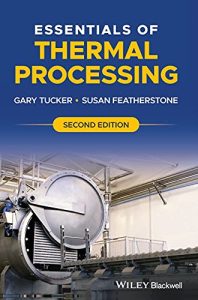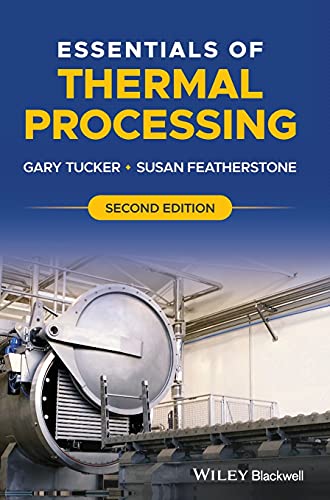Essentials of Thermal Processing 2nd Edition Gary Tucker
$50.00 Original price was: $50.00.$25.00Current price is: $25.00.
Essentials of Thermal Processing – Ebook Instant Download/Delivery ISBN(s): 1119470374

Product details:
- ISBN-10 : 1119470374
- ISBN-13 : 978-1119470373
- Author: Gary Tucker, Susan Featherstone
Among all food preservation methods in use today, thermal processing remains the single most important technique used in the industry. The newly revised Second Edition of Essentials of Thermal Processing delivers a thorough reference on the science and applications of the thermal processing of a wide variety of food products. The book offers readers essential information on the preservation of food products by heat, including high-acid foods and low-acid sterilized foods requiring a full botulinum cook.
The accomplished authors—noted experts in their field—discuss all relevant manufacturing steps, from raw material microbiology through the various processing regimes, validation methods, packaging, incubation testing, and spoilage incidents.
Two new chapters on temperature and heat distribution, as well as heat penetration of foods, are included. More worked and practical examples are found throughout the book as well. Readers will also benefit from the inclusion of:
- A thorough introduction to the microbiology of heat processed foods, food preservation techniques, low acid canned foods, and high acid foods
- An exploration of acidified products, heat extended shelf-life chilled foods, and processing methods
- Discussions of cooking and process optimization, process validation, and heat penetration and process calculations
Table contents:
1 History of Thermal Processing
1.1 A brief history of the science and technology of thermal processing
1.2 Food Microbiology as a Science
1.3 Packaging for Heat Preserved Foods
1.3.1 Convenience – the can opener is invented
1.3.2 Other forms of packing for “canned foods”
1.4 Developments in Cannery Equipment
1.5 Food Safety
2 Microbiology of Heat Preserved Foods
2.1 Food microbiology
2.1.1 Fungi
2.1.1.1 Moulds
2.1.1.2 Yeasts
2.1.2 Bacteria
2.1.2.1 Growth and reproduction of bacteria
2.2 Factors that affect the growth of microorganisms
2.2.1 pH
2.2.2 Moisture
2.2.3 Nutrients
2.2.4 Oxidation–reduction potential
2.2.5 Antimicrobial resistance
2.2.6 Biological structures
2.2.7 Relative humidity
2.2.8 Oxygen content/concentration of gases in the environment
2.2.9 Temperature
2.3 Description of some microorganisms of importance to thermal processing
2.3.1 Moulds
2.3.2 Yeasts
2.3.3 Bacteria
2.2.3.1 Thermophiles
2.3.3.2 Mesophiles – spore-forming bacteria
2.3.3.3 Mesophiles – non-spore forming pathogenic and spoilage bacteria
2.3.3.4 Psychrophiles
2.4 Risk of leaker spoilage from damaged or compromised packaging
2.5 A guideline for identifying spoilage in canned foods
3 Hurdles to Microbial Growth
3.1 Control of the microorganism loading
3.2 Use of restrictive pH levels
3.3 Anaerobic environment or modified atmosphere environment
3.4 Low temperatures
3.5 Dehydration or low water activity
3.6 Chemical preservation
3.6.1 Organic acids
3.6.2 Sulphites and nitrites
3.6.3 Antibiotics
3.6.4 Antioxidants
3.7 Irradiation
3.8 Combination Treatments
4 Low Acid Canned Foods
4.1 Production of a thermally processed food
4.2 F03 sterilisation processes
4.3 Commercial sterilisation
4.4 Microorganism death kinetics
4.5 Log reductions
5 Acid and Other Pasteurized Products
5.1 Background
5.1.1 Naturally acid foods
5.2 Pasteurisation
5.2.1 Considerations when designing a safe pasteurisation process
5.2.2 Calculation of pasteurisation values
5.3 Inhibitory factors to microorganism growth
5.4 P-value guidelines
5.4.1 High acid: pH < 3.5
5.4.2 Acid: pH 3.5–4.0
5.4.3 Acid: pH 4.0-4.2
5.4.4 Medium acid: pH 4.2–4.6
5.5 Guidelines and General Recommendations
5.5.1 Guidelines to critical factors in thermal processing of acid foods
5.6 Thermal processing of fruit
5.3.1 Packaging selection
5.3.2 Oxidation reactions inside an internally plain can of acid fruit
5.3.3 Pigments that discolour in internally plain cans
5.7 Thermal processing of products with low water activity
5.7.1 Jam and high sugar preserves
5.7.2 Canned cake and sponge pudding
5.8 Thermal processing of cured meats
6 Acidified Foods
6.1 Background
6.2 Acidity measurement using pH
6.2.1 The history of pH
6.2.2 The chemistry of pH
6.2.3 Measurement of pH
6.2.3.1 Potentiometric method
6.2.3.2 Colorimetric measurement
6.2.4 Equilibrium pH
6.3 Acidification of foods
6.4 Processing acidified foods
6.5 Design of pasteurisation processes
6.5.1 Medium acid range: pH 4.2–4.6
6.5.2 Acid range: pH 3.5–4.2
6.5.3 High acid range: pH below 3.5
6.6 Hot fill and hold processing
6.7 Critical control points in the production of acidified foods
6.7.1 Ingredients
6.7.2 Heat processing
6.7.3 Post process equilibrated pH
6.7.4 Container integrity
6.7.5 pH during product shelf-life
7 Heat Preserved Chilled Foods
7.1 Understanding microorganism behaviour
7.1.1 Pathogenic microorganisms relevant to chilled foods
7.1.1.1 Clostridium botulinum
7.1.1.2 Bacillus cereus
7.1.2 Microorganisms likely to be found in chilled foods
7.2 Methods of manufacture
7.2.1 Thermal process step applied prior to packaging
7.2.1.1 Low care–high care factories
7.2.2 Thermal process step applied after packaging
7.2.2.1 Caution with latent heat for frozen protein
8 Processing Systems
8.1 In-pack processing: Retort systems
8.1.1 Condensing steam retorts
8.1.2 Crateless retorts
8.1.3 Water immersion retorts
8.1.4 Water spray and cascade
8.1.5 Steam / air retorts
8.1.6 Shaka retorts
8.1.7 Reel & spiral retorts
8.1.8 Hydrostatic retorts
8.2 In-line processing: Heat exchangers
8.2.1 Flow behaviour
8.2.2 Choice of heat exchanger
8.2.3 Maximising product recovery
7.3 New thermal technologies
9 Cook Values and Optimisation of Thermal Processes
9.1 Mathematical analysis of cooking
9.1.1 Cooking equations and kinetic data
9.1.2 Competition between sterilisation and cooking
9.1.3 Optimisation of temperature / time in processing
9.2 Setting process targets
9.2.1 How to select processing conditions without excess quality damage
People also search:
essentials of processing assessment
thermal processing unit
essentials of thermal processing
k-ess2-2 activities
k-ess2-2 lesson plans
kerastase thermal nectar
You may also like…
Uncategorized
Biology and other natural sciences - Ecology
Medicine & Health Science
Engineering - Energy & Power Resources
Uncategorized
Engineering - Engineering - General & Miscellaneous
Uncategorized













